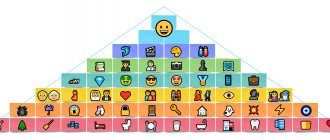What are needs
The key word in defining the concept of need is “need”.
Need
- this is the need for certain things, objects of the material world, objects, people, social indicators, in the absence of which a person feels uncomfortable.
Taking into account this definition, neediness, in order to become a need, must meet the following criteria:
- A lack of need causes a feeling of dissatisfaction. A need is something desired, a good.
- Accompanying with emotions: from negative at the first stage to joyful after the need is fulfilled. When we really want something, we get nervous and anxious; when we get what we want, we relax.
- Fixation on the subject of need. Consciousness snatches from reality those things that can satisfy us. For example, if we are hungry, we will focus on the food and the smell of food.
The system of needs is also formed according to special rules:
- Need is common to all living beings on the planet. But the more developed the species, the higher the level of needs. The tree has enough nutrients from the soil, sunlight, and rain watering. Man, as a highly developed animal, needs much more.
- The older the person, the more extensive the list of what is required. A baby can do without things that an adult needs.
- Needs are a strictly hierarchical structure, some are primary, others are secondary.
People's actions are dictated by the presence of a certain need, which is the main motivator of activity. Motivation to get what you want moves a person forward and forces him to act. Everything that has been created by people throughout the history of mankind in politics, economics, art, science is the result of activities to satisfy needs.
The inability to fulfill needs can lead to dependence on their importance for the individual and to the following various consequences:
- Physical death of a person
. If the need for food, sleep, water, air, safety, etc. is not satisfied. - Frustration
is a long-term experience associated with a nervous disorder and can lead to serious psychological problems. An example is the lack of recognition of a person’s merits by society. - Sublimation
- the transition of the energy of dissatisfaction into creation, creativity. For example, the absence of sex is replaced by heavy sports activities.
Thus, needs should be listened to and efforts should be made to realize them.
Theory and practice
In theory, everything looks quite interesting. Maslow's coherent theory of needs is very logical; it really describes reality and nature well for most people around. But over time, there were many critics of this theory, since in practice it began to increasingly diverge from reality.
The theoretical calculations of A. Maslow began to be actively applied in practice. Here are just a few areas of activity where they were adopted:
- Psychology and sociology. Researchers began to look at society and typical human needs with greater understanding and began to see patterns in all this;
- Maslow's theory is applied in human resource management systems to increase employee motivation and increase their ability to work and efficiency;
- There are many tips on how you can use Maslow’s pyramid in marketing, where it allows you to attract attention and encourage people to make purchases and orders.
Also, the theory continues to interest theoretical researchers who are trying to clarify and supplement it to this day.
What needs does a person have?
Man is one of the representatives of the animal world, with instincts and needs inherent in other species. At the same time, we have higher intelligence, feelings, and strong-willed qualities. This combination causes the presence of needs at two levels: basic and additional (primary and secondary).
Basic Needs
This group is vital for humans as a biological species. Basic needs are divided into two groups.
| Physiological | Existential |
| Breathing, nutrition, thirst, sleep, rest, procreation, housing. | Comfort, social and legal security, availability of employment, etc. |
Physiological basic needs must be satisfied first, since without them existence itself is impossible. The listed things and phenomena have been inherent in man since primitive times.
A person tries to make the process of satisfying basic needs more comfortable. If at the initial stage of the development of the human race animal skins served as clothing, today a whole industry is working to clothe us.
Basic needs can change with age in favor of the predominance of some over others. Sleep, for example, is more important for young children and older people, but in our youth we are able to get by with minimal hours of rest and still feel alert. Sex, as a primary need, can also, for a number of reasons, lose priority with age, but in adolescence it is a priority.
Questions often arise about security as a necessity for existence. Man has always experienced danger from phenomena in the surrounding world or from other people. A tsunami, a collapse of glaciers, an attack by wild animals or other tribes - all this forced a person to defend himself or run away. Over time, entire institutions were formed that were supposed to protect the individual from external incursions (army, police, Ministry of Emergency Situations). That is why safety is a primary need; we must understand that our lives and property are protected and protected.
The needs of existence (existence) appear as an individual grows up and determines his place in society.
Secondary needs
If a group of primary needs is necessary for survival and is laid down at the genetic level, then secondary needs determine a certain level of a person’s quality of life and come and are transformed with life experience.
Among the secondary needs in theory, the following are identified:
- Spiritual
. These include the need to obtain new knowledge about the world, the search for the meaning of life and one’s place in it, the development of creative abilities, and the desire for harmony. - Social
– love, friendship, interaction with other people, feeling part of society, a separate social group (class, work team, family). - Prestigious
. We are talking about the need for recognition of our successes, worthy self-esteem, respect from other members of the communities in which we belong.
Thus, primary needs are innate and determined by physiology, while secondary needs are psychological in nature and develop throughout life.
Awareness of your own uniqueness
We always have a conflict of two needs: not to be a “black sheep” and, at the same time, not to be like everyone else. In different situations, one motive wins, then another. And from this point of view, self-affirmation can be considered as the implementation of both the first and second motives.
First, we assert ourselves in order to “keep up” with the others, not to be an outsider. Have time to start a family, get an education, have a decent job, have your own home.
Then we assert ourselves to show that I am not like the others. I am an indispensable specialist in my field, I am a modern, understanding mother, I am a creative person who does something unique.
Types of needs
Needs can be classified on various grounds, of which there are quite a lot in the theory of psychology. The main types of division of needs are presented in the next section.
If we summarize all available theories, then we should distinguish three basic types of human needs.
Biological or physiological
Among the innate human needs laid down at the genetic level are the following:
- Food safety and taste characteristics.
- Comfortable external temperature and electromagnetic background.
- Clean water suitable for quenching thirst.
- Healthy ecology.
- Safety of life and home.
- Sexual satisfaction.
- Disposal of waste products.
These things are necessary for any living creature. This set of needs has practically not changed since the creation of the world, since from a physiological point of view, we are the same as millions of years ago. A person strives to realize them first and foremost and immediately.
Spiritual
Existential needs come from a system of universal human spiritual values, including: beauty, mercy, tranquility, harmony, peace, art. Each person has their own spiritual needs (as opposed to biological ones) and change over time and experience.
Among the spiritual needs are the following:
- The need for knowledge
. A mature person understands that in order to further grow, he must constantly learn. Moreover, expand the boundaries of existing skills and acquire new ones. People enter educational institutions to receive additional education, take advanced training courses, master new professions, and master the basics of painting and music. - The need for constant work on oneself, improving one’s personality (self-improvement)
. By satisfying this need, we quit smoking, go on a diet, get rid of toxic people and harmful emotions. A person thinks about how he would like to see himself after a certain period of time and strives for this. - The need for love and personal happiness
. The vast majority of people dream of having a loved one of the opposite sex nearby and creating a stable family. Many have been searching for many years, this need is so strong.
The realization of spiritual needs can be carried out through the simplest things. For example, a person goes into nature and sits with a fishing rod, fishing. At this time, he reflects, calms down, acquires spiritual harmony, satisfying his need for peace and making plans for the future.
Social
This type of needs is aimed at understanding one’s place in society and is associated with groups of people, social and economic activity.
Examples of social needs:
- Personal identification
. A person positions himself as a part of society with common traits inherent in society or a separate group. At the same time, he recognizes himself as an individual unit with a set of specific qualities and characteristics. - Self-affirmation
. We want to be satisfied with ourselves, with the actions and deeds that we perform. It is also important for a person to feel significant in society, to enjoy respect and approval from other people.
- Altruistic aspirations
. The individual takes pride in actions aimed at helping and assisting other people or living beings. He needs to be needed, useful, even in conditions of abandoning his own interests.
All of these types of needs are interpenetrating, they complement each other, some follow from others. For example, having satisfied the spiritual need to acquire a profession, we strive to achieve success in work for which we will be praised, and this is already a social need.
Creative self-realization
They perceive the benefits of civilization and the creations of culture, which people use every day in everyday life, as something completely natural, as a result of the development of industrial and social relationships. However, behind such a faceless vision there is hidden a huge number of scientists and greatest masters who cognize the universe in the process of their personal activities. After all, it is the creative activity of predecessors and contemporaries that is the basis for the progress of material production and spiritual creations.
Creativity is an invariable attribute of an individual’s activity. It implies a historically established evolutionary form of activity of subjects, which is expressed in various activities and leads to the formation of personality. The basic criterion of a spiritually developed personality is considered to be its mastery of the complete process of creativity.
Creative activity is a derivative of the subject’s realization of unique capabilities in a specific area. That is why there is a direct connection between the creative process and the implementation of the subject’s abilities in a socially significant type of activity that has signs of self-realization.
It has long been an established fact that the most complete development of an individual’s inclinations and talents is possible only through the performance of socially significant activities. At the same time, it is quite important that the implementation of such activities is determined not only by external factors (of society), but also by the internal needs of the individual. Under such conditions, the activity of the individual is transformed into amateur performance, and the realization of abilities in the chosen activity acquires the features of self-realization. From this it follows that creative activity is an amateur activity, covering the transformation of reality and personal self-realization in the process of creating material wealth and spiritual values. Creative self-realization of the individual allows one to expand the boundaries of human potential.
In addition, it should be noted that it is not so important in what exactly the creative aspect is expressed, in the ability to skillfully operate a loom or in virtuoso playing the piano, in the ability to competently and quickly solve various inventive problems or organizational issues. After all, no type of activity is far from a creative approach
It is not at all necessary that every member of society knows how to write poetry or paint pictures. The combination of all the natural forces of an individual, the expression of all his personality traits in action, contribute to the formation of individuality, accentuating his extraordinary qualities and unique features.
Fully mastered creativity by an individual means that he or she is following the path of developing the spiritual component of personal growth.
Creative self-realization of the individual is the area of application of the individual creative potential of the subject and the development of his reflexive attitude towards his own personality. Any type of creativity is a unique process of developing a personal worldview. Through creative activity, individuals independently acquire new knowledge and techniques. As a result of the acquired experience through such activity, the individual develops an emotional and value-based attitude towards his own personality and the reality that surrounds him. An individual achieves a certain degree of creative self-realization by using creative potential and expressing his creative essence.
Classifications of needs
Theoretical psychology offers many classifications of needs. We have already discussed one of them above: physiological, social and spiritual, these are the main groups of needs.
Foreign researchers did not so much classify needs as offer a specific list of them.
Examples:
- G. Murray
- achievements, aggression, independence, sex, creativity, understanding, respect, self-knowledge. - A. Pieron
- novelty, hedonism, communication, competition, mutual assistance and others (more than 20 types in total); - E. Fromm
- significance, self-affirmation, communication, affection, self-identification.
Some scientists have identified so-called neurotic needs as a separate group, the lack of satisfaction of which can lead to mental illness. These include: lack of social and interpersonal justice, the need for support and empathy, recognition, and possession.
In Russia, a classification of needs has been adopted, which divides them into the following levels:
- Based on the nature of the emergence of needs - natural and cultural
. - Depending on the area of application - communicative
(communication with other people),
cognitive
(the need to acquire new knowledge),
labor needs
, etc. - In relation to the object to which the need is directed - biological, material, spiritual and social
. - Correlating to their origin - endogenous
(determined by internal factors) and
exogenous
(depending on external conditions).
As we see, the number of human needs is numerous; today there is no complete list of them; there are only generalized groups and types. The most famous theory that places all types of human needs in order of priority is Abraham Maslow's Hierarchy of Needs.
The psychologist drew a whole pyramid, where needs are indicated in ascending order. This is what she looks like.
Maslow assured that until a person has satisfied the needs of the widest part of the pyramid, he will not strive to receive benefits from the higher levels. For example, if a person is hungry, then he has no time for public recognition. He considered hunger not only in relation to food, but also to sleep, thirst, sex, etc.
Maslow’s rule does not work in the opposite direction: an individual who has fulfilled the need for respect and recognition still needs food and sleep.
The need for belonging to a reference group and teamwork
In any company, in addition to the official, staff structure, there is an informal structure of relations between employees, which arises on the basis of mutual assessments and likings.
The need to be together with everyone is expressed in the desire to become accepted by team members, to have positive relationships with colleagues and likeable employees. The desire to belong to a reference group is present in all employees, both sociable and closed. “I want to work in a team,” say people who have a dominant need for teamwork. This is manifested in the fact that employees go to lunch together, drink tea, smoke, discuss corporate news, sports achievements of their favorite team, etc.
If the need to belong to a group is not satisfied, the employee becomes an outsider and takes it hard. The difficulties of social adaptation of a new employee in a consolidated team are associated precisely with the difficult inclusion in informal, friendly interaction.
Motivators for employees who need teamwork:
- Know the informal structure of your unit (company).
- Maintain good relationships with opinion leaders who have positive values.
- Delegate important professional tasks to informal leaders.
- Direct informal leaders-peacemakers to regulate conflicts between employees.
- In order to facilitate the social adaptation of new employees who have a need for teamwork, select a mentor from among experienced employees.
- Create permanent working groups.
- Designate separate areas for team work.
- Maintain team symbols and insignia.
- Encourage quick meetings to share information and opinions within the team.
- Express satisfaction with the team's successful performance in formal meetings.
- Introduce a corporate requirement for a formal suit for all employees and the same uniform for workers.
- Send the entire team to training, exhibitions, and conferences as a reward for successful work.
- Encourage team sports and competitions between teams, and team building training.
- Create conditions so that employees can exchange words while working.
- Give work groups breaks to work together so they can socialize.
Formation of human needs
Taking into account the considered classification of needs, we can talk about the features of their formation. Basic physiological needs are innate, transmitted to us at the genetic level. A person lives with them until his death; without receiving them, he dies physically.
Such needs cannot be prohibited or imposed by force. Primary needs cannot be good or bad, pure or dirty. Only ways and methods of satisfying them can be considered unworthy. For example, a person uses a public space instead of a toilet.
Primary spiritual needs also appear with a person. The presence of love, close people, harmony, and self-realization in life are mandatory for his mental health. Of course, without the listed benefits, a person will not die, but he will be stuck in reflection and frustration for a long time.
Secondary needs are formed in an individual in several stages.
Infancy
All the physiological needs of the baby are provided by his parents. Since the child has contact with adults, social needs arise even before six months: he smiles, looks at rattles, identifies mother and father.
Earlier childhood
At about the age of 3 years, the baby develops an understanding of objects to satisfy needs - he realizes the need for toys, certain food, specific clothing. Cognitive needs grow, the child reads books, sculpts, draws, and actively explores the world.
Preschool period, primary school age
Children's social environment expands significantly. In addition to mothers and grandmothers, they have their own friends - children from kindergarten, class, yard or clubs where he begins to go. The need for communication, recognition, mutual assistance and understanding is formed.
Teenagers
At this age, the last physiological need is revealed - sexual. For the first time, such secondary needs as self-realization and self-improvement are formed. There is a sharp change and expansion of cognitive interests. A teenager strives to learn about those things and objects that he did not even think about in the early periods of his life.
On the basis of the formed sexual need, a need for a person of the opposite sex and romantic experiences appear. The need for communication is shifting towards peers and friends. Relatives fade into the background.
It is believed that by the end of adolescence, all the basic needs of a person have already been developed. Their further development occurs through changes in their content and methods of achievement.
Methods of self-affirmation
The “healthiest” and most productive way of self-affirmation is self-realization, that is, the desire to fully realize one’s capabilities. A person determines his desires, evaluates his potential and sets a certain goal, the achievement of which is success and a person can say: I have asserted myself in this life.
Giphy
It is important to understand that we all strive for development, therefore, after achieving a set goal, a person, as a rule, will set a new goal for himself. This is fine. The process of self-actualization is endless.
But there are other ways of self-affirmation, for example, compensatory - a person cannot achieve success in the desired area and switches to another.
Self-affirmation can be real or illusory, in which case the personality:
- or he only talks about his self-affirmation, that is, he deceives others, wanting to raise his social status;
- or exaggerates her achievements and their significance, wanting to deceive herself.
Both options lead to intrapersonal conflict.
One of the most destructive ways to assert yourself is to try to assert yourself at the expense of others. This is a way to increase your importance and self-esteem by belittling others.
This method of self-affirmation is aggressive in nature and is expressed in:
Photo by Quinten de Graaf on Unsplash
- insults;
- biased criticism;
- judging others for their views and actions;
- intimidation;
- manifestation of moralfag behavior;
- provocative or arrogant behavior;
- generating conflicts;
- bullying;
- manifestations of aggression towards minorities or certain phenomena;
- desire to win an argument rather than reach a solution;
- hate on social networks, etc.
Behind such behavior is sometimes low self-esteem and an inability to self-realize in this life.
How to learn to “accept”?
- Start regularly tracking and noticing when other people do something nice for you. Each time, note what reactions the pleasant thing they did for you will cause you. Be aware of what you felt, what you thought, what sensations appeared in your body in response to this, what images arose in your mind.
- Notice how you interpret situations when other people do something for you. What meaning do you attach to these situations? And also think about why you interpreted this situation this way. How does this relate to your story, your past experiences?
- Work through (preferably with a psychologist) traumatic situations from the past that cause you to react negatively when other people do something nice for you.
- Learn to directly ask others for what you need. Don't wait for the other person to figure it out and give you what you want from them. Help other people do nice things for you - tell them what you want and directly (but politely) ask them to do it for you.
Advantages and disadvantages
Maslow's pyramid is valuable for studying large masses of people when there is no need to look closely at individuality. If we talk about its pros and cons, we can highlight the following:
- Pros. The ability to understand large masses of people, the applicability of theory to work in large teams, the ability to explain the behavior of individual people quite accurately, and have leverage over them. Also, thanks to theory, you can better understand yourself;
- Of the minuses: A. Maslow could not thoroughly describe each individual with his theory, take into account the variability of character, inconstancy, the presence of geniuses, dependencies on certain things. Many people behave differently and do not have the priorities that they should have, if assessed from the point of view of Maslow's theory.
Many psychologists believe that the pyramid is already outdated and today, when most people do not worry about low needs, it does not reflect reality.
What is the meaning of Maslow's pyramid
If Maslow’s pyramid is considered, the human needs in it are stated rather conditionally, vaguely, the theory is sometimes far from practice. But it has a meaning and it is quite simple - looking at the picture of the pyramid, we must understand that a person is a complex being and there are things that concern him first, and there are things that can be put off until later.
By understanding what motivates people, you can effectively build communication and work process with them, find the right incentives for collaboration and increase the efficiency of employees.
Application of Maslow's pyramid
Maslow's pyramid can be most successfully applied in certain areas, such as:
- marketing
- life
- work and business
- when building a career
- running a company
Let's expand on each topic a little for a broader understanding.
Application in marketing
Maslow shows human needs in the form of a hierarchy, so marketing companies and marketers can rely on this theory in order to understand exactly how to attract this or that category of people. If it is necessary to motivate, say, employees, then lower incentives such as increasing salaries or reducing working hours work here; management employees are already concerned about other issues: comfort, conditions for career growth, respect from management.
Application in life
The application of this theoretical concept in life is quite limited, but it can be useful for every person. We must not only look at what is at the top of Maslow's pyramid, but also cover basic needs if there are problems there. This will help relieve stress and tension, cope with professional burnout, and open up mental strength for new and greater achievements.
Maslow's pyramid in work and business
In these areas, the use of the theory under consideration comes down to competently stimulating your employees, understanding how to properly influence their performance, attitude towards work and work responsibilities. By managing to some extent the basic needs of people and clients, we can make ourselves more attractive in their eyes and offer solutions to specific pressing problems. After all, a business is more successful the more effectively it solves a client’s problem.
In building a career
In career matters, we should always remember what is at the top of Maslow's pyramid, but not try to jump straight there, since such a “maneuver” is available to very few geniuses. In a career, the pyramid will always help you remember that there are basic things that we cannot turn a blind eye to, so that they do not drag us down and close off the possibility of further growth. For example, if we work in conditions of low wages and cannot provide for our family, we work without respect from colleagues and superiors - this will greatly hinder or even slow down our growth.
In the practice of enterprise management
You can use Maslow's theory in business management. Here, too, everything is simple: each subordinate at his level and the ability to satisfy his needs must be selected with optimal incentives, satisfy these basic needs, or be given a real hope of satisfying them. If you add some qualities to your work that cover higher levels, you can also reduce stress from problems at lower levels. For example, a job where the boss respects and treats his subordinates well will be more interesting to many people than a high salary, but a bad attitude, which can lead to causes of professional burnout.











